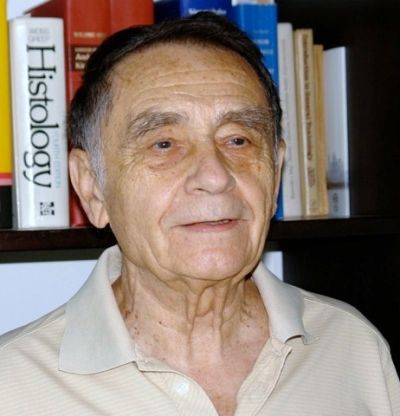Mirosław Jan Stasik (1929–2023). Doctor, toxicologist and promoter of science

Scientific achievements
Mirosław Stasik is the author of over 50 scientific publications in Polish, English, German and Japanese scientific journals, as well as articles in the Encyclopaedia of Occupational Health and Safety published by the International Labour Organization. He presented his research findings at international conferences of the International Commission on Occupational Health.
In 1968, he wrote a paper on the toxicity of tetraethyllead in humans while organising a conference of the toxicological information centres of the voivodeships in Lódź. The material for this article was obtained from the health records of patients in the department for acute intoxications at the Institute for Occupational Medicine (IMP) in Lódź. This was one of the first scientific papers on this topic in the world.[1]
In 1987 Mirosław Stasik proved the carcinogenic effect of 4-Chloro-o-toluidine (4-COT), which at that time was used as a raw material in the production of dyes and pigments, as well as of chlordimeform.[2] Stasik was able to show that this widely used substance can cause urinary bladder cancer among humans. Following the publication of the research results by Dr Stasik, the International Agency for Cancer Research officially recognised the carcinogenic effects of 4-COT on humans. This was the first industrial monocyclical aromatic amine to be recognised as a trigger for urinary bladder cancer. The production and use of this compound were halted in Germany and other countries worldwide.
After retiring, Mirosław Stasik worked as an independent employee of the Institute for Occupational, Social and Environmental Medicine (Institut für Arbeits-, Sozial- und Umweltmedizin) at the Johannes Gutenberg University in Mainz, where he continued his research into aromatic amines. He also collaborated with the professorial Chair for Histology and Embryology at the Medical University in Lódź.
Contributions to society
During the 1990s, Stasik also became known for his work to promote closer relations between Germany and Poland. He actively contributed to the work of the German-Polish Association (Deutsch-Polnische Gesellschaft) in Mainz-Wiesbaden, as well as the scientific Jablonowski Society (Societas Jablonoviana), for which he founded a branch office in Wiesbaden in 1997. He was co-organiser of presentations about Polish culture and of scientific conferences and symposia, and acted as an advisor and moderator.
In 2000, he participated in a scientific conference in Singapore, where he made contact with Prof. Konrad Rydzyński, who worked at the Institute for Occupational Medicine in Stasik’s native city of Lódź. In 2001, in response to the difficulties facing Polish scientists, Stasik and his wife Liliana set up the 4-COT Foundation (Stiftung 4-COT), which from 2002 to 2015 offered young scientists from the IMP in Lódź the opportunity to work as interns in scientific institutions abroad. Stasik became chair of the foundation, while Professor Rydziński was a member of the executive board. The foundation’s capital amounted to 130,000 Deutschmarks. This money was used to purchase stocks and shares on the Frankfurt stock exchange. The dividends gained between 2002 and 2015 were channelled into funding research work placements in the fields of medicine, biochemistry, clinical analytics and physics at universities in western Europe and North America. Mirosław Stasik looked through the candidates’ application papers at the foundation’s head office in Niedernhausen. The sum awarded for grants (allowances) totalled EUR 2,500. Dr Stasik himself sought out suitable work placement opportunities for the candidates, and helped on site with the formalities.
During their internships, the young scientists further increased their knowledge in the fields of asthma and occupational allergology, radiation protection and molecular biology. They also forged professional relationships with scientists from other countries in the field of occupational medicine. Most of the recipients of the grants from the 4-COT Foundation completed their work placements, which usually lasted a month, at the Institute for Preventive and Occupational Medicine of the German Statutory Accident Insurance (Institut für Prävention und Arbeitsmedizin der Deutschen Gesetzlichen Unfallversicherung, IPA) at the Ruhr University in Bochum. In addition, two work placements were completed in the Occupational and Environmental Medicine Department of the National Heart and Lung Institute at the highly respected Imperial College London and at the Ludwig Maximilian University in Munich. A two-month placement was also awarded at the Foothills Medical Centre of the University of Calgary in Canada.
Mirosław Jan Stasik died in Niedernhausen on 8 August 2023.
Joanna de Vincenz, January 2024
[1] Stasik, M. J. et al.: Acute tetraethyllead poisoning, in: Archiv für Toxikologie 24, 1969, p. 283–291.
[2] Stasik, M. J.: Carcinomas of the urinary bladder in a 4-Chloro-o-toluidine cohort, in: International Archives of Occupational and Environmental Health 60, 1988 (1), p. 21–24; Stasik, M. J.: Harnblasenkrebs durch 4-Chlor-o-toluidin [4-Chloro-o-toluidine-induced bladder cancer], in: Deutsche Medizinische Wochenschrift 116, 1991 (38), p. 1444–1447.


